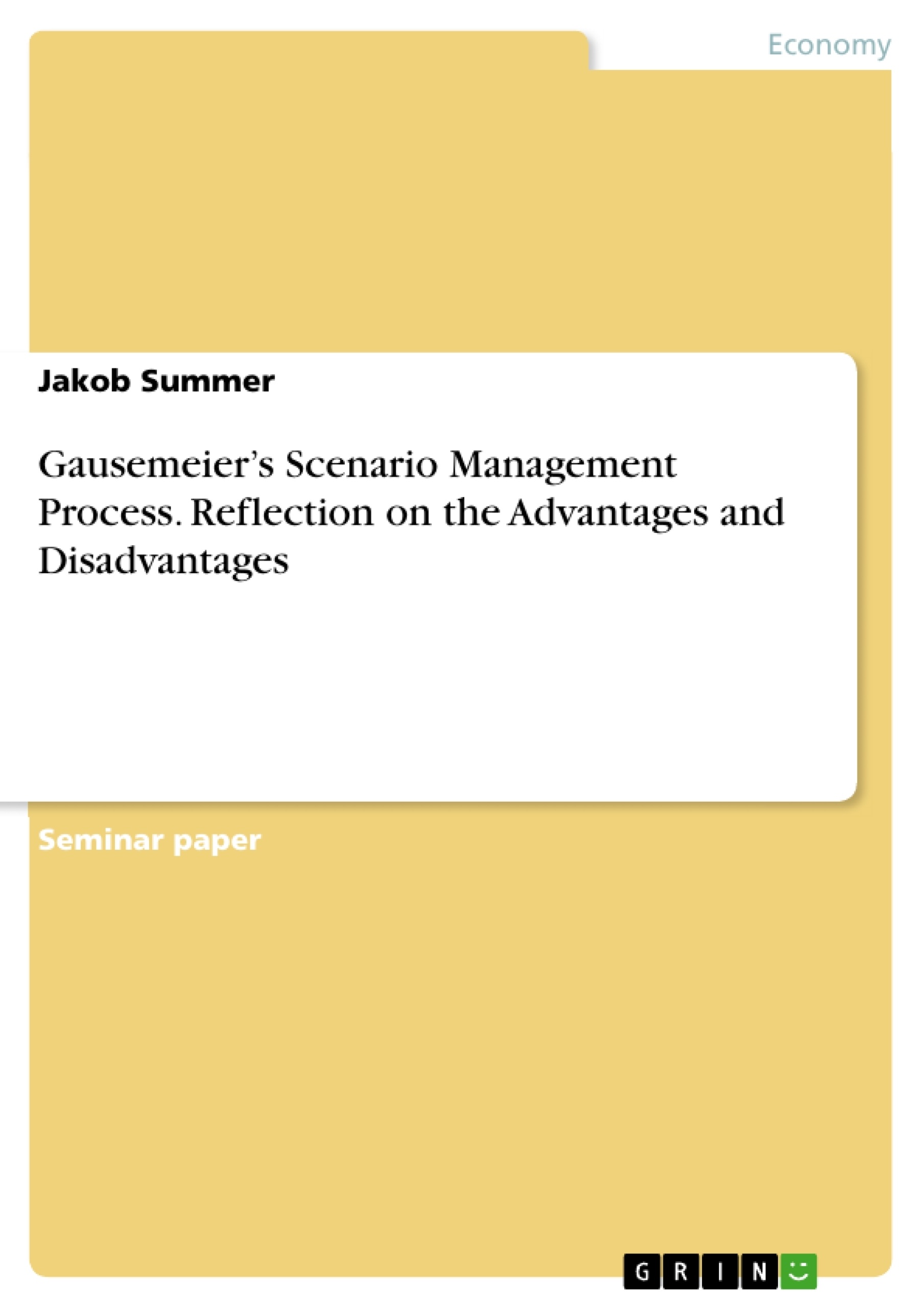The aim of this reflection paper is to state my personal opinion whether I consider this specific technique of strategic foresight based on its advantages and disadvantages as useful or not. The paper is structured as followed. To open the topic, Gausemeier's scenario approach is assigned to one of the three main scenario technique schools in chapter two. Following this, due to the limited scale of this paper, a very summarized overview of Gausemeier's five-phase model of scenario management is presented. In chapter four and five, the advantages and disadvantages of the Gausemeier scenario technique are objectively analysed. The reflection paper ends with a subjective evaluation of the Gausemeier approach by the author.
Inhaltsverzeichnis (Table of Contents)
- Introduction
- Overview on Scenario Techniques and Classification of Gausemeier's Approach
- Gausemeier's Scenario Technique
- Advantages of Gausemeier's Scenario Management Process
- Knowledge Sharing and Communication
- Consideration of Multiple Influencing Factors and their Interrelationship
- Creation of Multiple Futures
- Transfer of Scenarios into Strategic Planning
- Transparent, Traceable and Replicable Method
- Disadvantages of Gausemeier's Scenario Management Process
- Knowledgeable and Diversified Participants are Required
- Time and Resource Intensive Process
- Limitations due to Complexity
- Risk of Subjective Impacts
- Discussion
Zielsetzung und Themenschwerpunkte (Objectives and Key Themes)
This reflection paper aims to analyze Gausemeier's scenario technique for strategic foresight, examining its strengths and weaknesses to assess its usefulness. The paper focuses on a summarized overview of Gausemeier's five-phase model of scenario management and analyzes its advantages and disadvantages. The author concludes with a subjective evaluation of the approach.
- Scenario technique as a strategic foresight method
- Gausemeier's scenario approach as a consistency-based method
- Advantages and disadvantages of Gausemeier's scenario technique
- Application of Gausemeier's scenario technique in real-world scenarios
- Subjective evaluation of the Gausemeier approach
Zusammenfassung der Kapitel (Chapter Summaries)
- Introduction: This chapter introduces the reflection paper and outlines its purpose. It explains the author's personal experience with Gausemeier's scenario technique and the paper's structure.
- Overview on Scenario Techniques and Classification of Gausemeier's Approach: This chapter defines scenario technique as a strategic foresight method and outlines its two main premises. It categorizes Gausemeier's approach within the consistency-based school of scenario techniques, contrasting it with other approaches like intuitive logic and cross-impact analysis.
- Gausemeier's Scenario Technique: This chapter presents a summarized overview of Gausemeier's five-phase model of scenario management, highlighting its purpose and key stages. The chapter also includes a diagram showcasing the five phases and their respective tools.
- Advantages of Gausemeier's Scenario Management Process: This chapter discusses the benefits of Gausemeier's approach, focusing on aspects such as knowledge sharing, consideration of multiple influencing factors, the creation of multiple future scenarios, and the transfer of scenarios into strategic planning. The chapter emphasizes the transparent and replicable nature of the method.
- Disadvantages of Gausemeier's Scenario Management Process: This chapter explores the drawbacks of Gausemeier's approach, highlighting the need for knowledgeable participants, the time and resource intensity of the process, the potential for complexity, and the risk of subjective impacts.
Schlüsselwörter (Keywords)
This reflection paper focuses on scenario techniques, strategic foresight, Gausemeier's scenario approach, consistency-based methods, scenario management, decision field, influencing factors, key factors, future projections, scenario development, scenario transfer, knowledge sharing, complexity, and subjective impacts. The paper explores the advantages and disadvantages of Gausemeier's scenario technique and its applicability in real-world contexts.
- Arbeit zitieren
- Jakob Summer (Autor:in), 2021, Gausemeier’s Scenario Management Process. Reflection on the Advantages and Disadvantages, München, GRIN Verlag, https://www.grin.com/document/1358278



